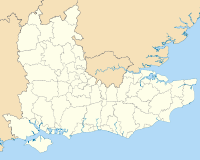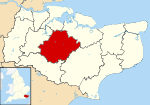- Maidstone (borough)
-
Maidstone District — Non-metropolitan district — Maidstone shown within Kent Sovereign state United Kingdom Constituent country England Region South East England Non-metropolitan county Kent Status Non-metropolitan district Admin HQ Maidstone Incorporated 1 April 1974 Government - Type Non-metropolitan district council - Body Maidstone Borough Council - Leadership Leader & Cabinet (Conservative) - MPs Hugh Robertson
Helen GrantArea - Total 151.9 sq mi (393.3 km2) Area rank 103rd (of 326) Population (2010 est.) - Total 149,800 - Rank 124th (of 326) - Density 986.5/sq mi (380.9/km2) - Ethnicity 97.3% White
1.1% S.AsianTime zone GMT (UTC0) - Summer (DST) BST (UTC+1) ONS code 29UH OS grid reference TQ7588156056 Website maidstone.gov.uk Maidstone is a local government district with borough status in Kent, England. Its administrative centre is Maidstone which is also the County town of Kent. grid reference TQ760560
The district was formed on 1 April 1974 under the Local Government Act 1972, and was a merger of the former municipal borough of Maidstone with the rural districts of Hollingbourne and Maidstone.[1]
Contents
Position
The Borough covers an area generally to the east and south of the town of Maidstone: as far north as the M2 motorway; east down the M20 to Lenham; south to a line including Staplehurst and Headcorn; and west towards Tonbridge. Generally speaking, it lies between the North Downs and the Weald, and covers the central part of the county. The M20 motorway crosses it from west to east, as does High Speed 1.
Geologically, the Greensand ridge lies to the south of the town. The very fine sand provides a good source for glass-making. The clay vale beyond, through which flow the three rivers which meet at Yalding; the Medway, the Beult and the Teise; and the chalk North Downs all provide raw materials for paper- and cement-making; which are also local industries.
Governance
See also: Maidstone local electionsMaidstone Borough[2] represents the second tier of local government, being one of the local government districts of Kent. The Borough Council consists of 55 councillors, representing voters from 26 wards. Twelve of those wards are within the urban area of Maidstone: they are Allington; Bridge; Downswood & Otham; East ward; Fant; Heath; High Street; North ward; Park Wood; Shepway North; Shepway South; and South ward. The remaining 14 wards cover rural districts.[3]
From 1983 to 2008 no party had a majority on Maidstone Borough Council, but the Conservative party gained a majority at the 2008 election. As of the 2010 election the council has 28 Conservative, 23 Liberal Democrat and 4 independent councillors.[4]
The council is based in the town centre having replaced its many small offices with one large, multi-million pound building called Maidstone Gateway. The shopfront appearance means it is easier to access the information you want.
The third tier of local government is the civil parish; in Maidstone some of the parishes have a neither a parish council or a parish meeting, as indicated (1) :
- Staplehurst
- Stockbury
- Sutton Valence
- Teston
- Thurnham
- Tovil
- Ulcombe
- West Farleigh
- Wichling (1)
- Wormshill (1)
- Yalding
Transport
Water
The River Medway was the earliest form of transport through the area. It was navigable for cargo-carrying craft as far upstream as Tonbridge, and it was only in the 19th century that the railways brought any change. More recently, various works have been carried out to control the frequent flooding in the clay vale upstream of Maidstone.
Roads
Maidstone, as its importance warranted, has been the hub of roads for many centuries. It lies very close to the Pilgrims' Way; and two Roman roads met south of the town: one from Rochester to Hastings the other branching off to the East Kent coast and Dover.
In the 18th Century came the turnpiked roads. One of the earliest in the county - that to Rochester and Chatham - was opened in 1728.
In modern times, two motorways - the M2 and the M20 - pass to the far north of the borough and just north of the town centre of Maidstone respectively.
Railways
The earliest line through Kent was built by the South Eastern Railway. It was not, however, built to pass through Maidstone: instead, a station was built at Paddock Wood, then named Maidstone Road, some six miles away. It was only in the period between 1844 (when that main line was connected by a branch line to Maidstone) and 1884 that Maidstone became a hub once more, although with local trains only, to Strood, Ashford and (via Swanley Junction to London.
References
- ^ The County of Kent (Electoral Changes) Order 2004
- ^ Maidstone Borough Council website
- ^ List of councillors on Maidstone Borough Council, showing wards they represent
- ^ "Maidstone". BBC News Online. 19 April 2009. http://news.bbc.co.uk/1/shared/election2010/council/html/3716.stm. Retrieved 11 March 2011.
Video clips
 Districts of South East England
Districts of South East EnglandBerkshire 
Buckinghamshire Aylesbury Vale • Chiltern • Milton Keynes • South Bucks • Wycombe
East Sussex Brighton and Hove • Eastbourne • Hastings • Lewes • Rother • Wealden
Hampshire Basingstoke and Deane • East Hampshire • Eastleigh • Fareham • Gosport • Hart • Havant • New Forest • Portsmouth • Rushmoor • Southampton • Test Valley • Winchester
Isle of Wight Kent Ashford • Canterbury • Dartford • Dover • Gravesham • Maidstone • Medway • Sevenoaks • Shepway • Swale • Thanet • Tonbridge and Malling • Tunbridge Wells
Oxfordshire Surrey Elmbridge • Epsom and Ewell • Guildford • Mole Valley • Reigate and Banstead • Runnymede • Spelthorne • Surrey Heath • Tandridge • Waverley • Woking
West Sussex Adur • Arun • Chichester • Crawley • Horsham • Mid Sussex • Worthing
Categories:- Local government in Kent
- Maidstone (borough)
- Unreferenced Kent-related articles
- Non-metropolitan districts of Kent
- Local government districts of South East England
Wikimedia Foundation. 2010.

